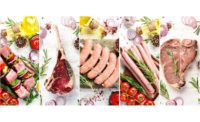Meat in the middle of the plate, vegetables on the side: A familiar combination that now offers new possibilities in the market for alternative meat products. These have special appeal for consumers who want to eat less meat in general but are unwilling to compromise either on flavor or on consistency. “We see big opportunities for hybrid products, since they offer many benefits,” said Katharina Burdorf, team lead product management Hydrosol. “Vegetables, legumes, and mushrooms offer nutritional advantages, for one thing. And for another they cost less than meat, so recipes can be more economical.”
According to market research, 58% of consumers would try products containing a mix of animal and plant proteins. Hydrosol has developed the PLUSmulson series stabilizing systems for hybrid meat products and cold cuts. They are simple to use and easy to integrate into existing production processes. The meat and vegetable proportions can be varied flexibly. “In our sample recipes we use 60 percent meat and about 25 percent vegetables, but increasing the proportion of vegetables is no problem,” said Burdorf.
By adjusting the flavorings and types of meat, the system enables a wide range of hybrid products, from burgers, meatballs, nuggets and schnitzel to fish products. Production is done on conventional machinery, by mixing chopped meat and vegetables with other ingredients, like seasonings, and the stabilizing system. The mixture is then formed into burgers, nuggets or schnitzel. Thanks to its binding ability, the stabilizing system ensures good structure in the final products even with high vegetable content. The system is free of E numbers, so it is suitable for clean-label products.
Hybrid sausage and cold cuts can also be formed, as Hydrosol recently showed at Fi Europe with hybrid bratwurst. “Many visitors were amazed at the authentic flavour and texture. Feedback was positive all the way,” said Burdorf. Additionally, the hybrid products, whether sausage or meat alternatives, have a number of nutritional benefits. They contain less fat and cholesterol than conventional meat products but have the same amount of protein. Depending on the type of vegetables used, they can also have high fiber content.
Added benefits of hybrid products include lower CO2 emissions and a smaller ecological footprint. There are also business advantages for meat producers — hybrid products are a way to win back lost market share.
The type of vegetables contained can be leveraged for marketing purposes — for example, by advertising local or regional agriculture on packages. The products can also be tailored to appeal to ethnic taste preferences and thus different markets.
Hybrid products put the focus on flavor, health and convenience, but they take some explaining, as Burdorf noted: “Sales success depends greatly on the marketing communication. It’s important to point out the advantages of the products, as otherwise it can seem that the vegetables are just there to stretch the meat for cost reasons. Proactive communication can prevent that.”
What’s more, hybrid products offer strong innovation potential and open up new possibilities in combination with cultured meat. “For cost reasons, most companies will start by taking hybrid products to market,” said Burdorf. “Plus, combinations of cultured cells and plant-based proteins as a rule have higher consumer acceptance.”
Hybrid meat offers varying possibilties for marketing. The preparation potential ranges from economy recipes to high-end products, from gourmet creations to kids’ foods.
Source: Hydrosol GmbH & Co. KG



Report Abusive Comment